I'm not going to let The Professor win without any sort of competition!
Here is my flag for the Union Of Greater India: The flag design (both the orange colour and the swallow tail) itself is borrowed from the Maratha Empire, which in rather recent history ruled huge tracts of land on the Indian subcontinent. The cockade stands for the original flag proposal by Gandhi in 1921, with the white standing for purity, the red for the Indian people's sacrifice and the green for the Union's hope, as well as Republicanism. The white bar below the cockade symbolises the peace intended between the many ethnic groups of the Union. The hexagram in the centre of the cockade stands for the religious variety of the Union Of Greater India, seeing how the six-pointed star is an important symbol in Buddhism, Hinduism, Jainism and Islam, which all have followers within India.

Here is my flag for the Union Of Greater India: The flag design (both the orange colour and the swallow tail) itself is borrowed from the Maratha Empire, which in rather recent history ruled huge tracts of land on the Indian subcontinent. The cockade stands for the original flag proposal by Gandhi in 1921, with the white standing for purity, the red for the Indian people's sacrifice and the green for the Union's hope, as well as Republicanism. The white bar below the cockade symbolises the peace intended between the many ethnic groups of the Union. The hexagram in the centre of the cockade stands for the religious variety of the Union Of Greater India, seeing how the six-pointed star is an important symbol in Buddhism, Hinduism, Jainism and Islam, which all have followers within India.
Last edited:
